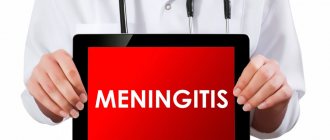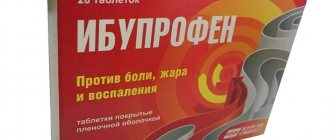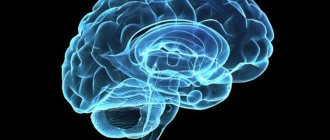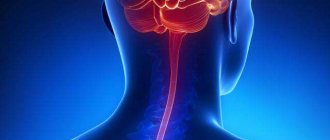Meningitis is an infectious disease in which an inflammatory process develops in the membranes of the brain. Infectious agents are transmitted from a sick person or carrier of microorganisms to a healthy person through contact or airborne droplets. Sometimes people become infected by eating food that is contaminated with animal excrement, water contaminated with microorganisms, or the bite of various insects.
The first signs of meningitis do not appear immediately after the patient becomes infected. The period of time between the entry of an infectious agent into the body and the appearance of the first symptoms of the disease is called the incubation period. For infectious meningitis, it varies from 4 to 10 days. Doctors at the Yusupov Hospital establish a diagnosis of meningitis using modern laboratory and instrumental studies.
Immediately after an accurate diagnosis is established, complex therapy begins. Infectious disease specialists prescribe the most effective antibacterial and antiviral drugs that quickly destroy pathogens. Detoxification therapy is carried out using modern infusion agents. To treat patients, drugs registered in the Russian Federation are used, which have a minimal range of side effects.
Types of meningitis
It is generally accepted that the first symptoms of meningitis were described by Hippocrates, and then by medieval healers. So humanity has known about this disease for a very long time. But for many years, tuberculosis was mistakenly believed to be the cause of inflammation of the meninges, and before the discovery of antibiotics, 95 out of 100 patients died from meningitis. Nowadays, treating meningitis is also not easy, but thanks to modern knowledge, the survival rate is much higher than several centuries ago.
However, for effective therapy, it is necessary to initially determine what type of meningitis will have to be dealt with. And this disease is very “many-sided” in origin and nature, therefore, in the international classification of diseases (ICD 10), each type is assigned its own code and definition, and specialists use different methods to systematize the disease.
According to the nature of inflammation, meningitis is divided into:
- purulent;
- serous.
In the first case, the disease is caused by meningococcal bacteria, is very severe, and is caused by a primary septic process. The second type is of viral origin and is considered less dangerous compared to purulent bacterial meningitis and is less likely to cause complications.
By origin, meningitis is divided into:
- primary (independent disease);
- secondary (appears as a complication of sinusitis, otitis, respiratory infections, osteomyelitis of the skull bones, caries, boils on the face or neck, tonsillitis, and sometimes occurs against the background of diseases such as tuberculosis, measles, mumps, syphilis).
Classification by pathogen:
- bacterial;
- fungal;
- viral;
- protozoan;
- mixed.
According to the nature of the flow:
- lightning (fulminant);
- spicy;
- subacute;
- chronic;
- recurrent.
By localization of inflammation:
- total;
- basal (affects the deep parts of the brain);
- spinal (affects the spinal cord);
- convexital (affects the superficial part of the brain).
According to severity:
- mild;
- medium heavy;
- heavy.
In addition, there is also non-infectious meningitis. This is a type of aseptic meningitis, that is, a disease caused by any other non-bacterial agents - non-infectious diseases, drugs or vaccines. Overall, these causes of meningitis are rare. Most often, doctors diagnose cases of viral, bacterial, secondary purulent and fungal meningitis. Moreover, the bacterial (meningococcal) variety of the disease is more common among children under 5 years of age, and the fungal type is more common among pregnant women, patients after chemotherapy, as well as patients with acquired immunodeficiency. Bacterial, also purulent, meningitis can affect even babies under one year old, and viral (serous) meningitis in children, as a rule, develops after mumps or Coxsackie viruses, ECHO. The viral form is not as dangerous for children as the purulent form, since it is easier to treat and less likely to cause complications.
Is it possible to get a secondary infection and what are the ways of transmitting the virus?
Note! You cannot become infected with secondary meningitis, which is the result of other diseases, traumatic brain injuries, or taking certain medications.
Primary meningitis, which is the result of viral and bacterial infections, can be transmitted in the following ways:
- Hematogenous (through the blood) - viruses and bacteria penetrate through blood vessels from the initial source of infection. In this way, infection with enterovirus, pneumococcal and meningococcal, tuberculous meningitis can occur.
- Transplacental - infection of a child in the womb from the mother. Most often, infection with the meningococcal type occurs this way.
- Fecal-oral – infection occurs due to lack of hygiene, dirty hands, living together and using common hygiene items with an infected person. Adenoviral, enteroviral meningitis and lymphocytic choriomeningitis are transmitted in this way.
- Airborne is the most common method of infection. Occurs due to the release of infections, viruses and bacteria during talking, sneezing and coughing of a sick person. Enterovirus, tuberculosis, meningococcal, adenovirus and meningitis caused by Haemophilus influenzae are transmitted in this way.
Causes of infection
In many clinical cases, meningitis manifests itself as a seasonal disease. But contrary to popular belief, hypothermia cannot be considered its main cause. Statistics indicate that more cases of infection occur in the warm season, as well as in countries with temperate climates. However, experts also record surges in the spread of the disease in the off-season. This is facilitated by several factors: increased humidity and decreased air temperature outside, seasonal hypovitaminosis, as well as longer stays in poorly ventilated areas. Not long ago, scientists noticed another cyclical pattern: every 10-15 years, an epidemic of meningitis is registered in the world. For example, in 2021, an epidemic of serous meningitis caused by the enterovirus ECHO30 from China was recorded in Russia.
Viral meningitis can be caused by enteroviruses, measles, rubella, chickenpox, herpes or mumps viruses. The bacterial variety of the disease is caused by staphylococci, meningococci, streptococci, salmonella, klebsiella, tuberculosis, pseudomonas or hemophilus influenzae. The causative agents of the disease are fungal etiology, Candida and Cryptococcus. The cause of protozoal meningitis can be protozoan microorganisms (intracellular parasites), and a mixed type of disease occurs due to the complex influence of several factors at once. The carriers of any meningitis are infected people.
People with weakened immune systems and children under 5 years of age are most susceptible to the disease (their immune system is still developing, and the blood-brain barrier is characterized by increased permeability). If we analyze the prevalence of the disease between the sexes, then more cases of inflammation in the brain are diagnosed among men (usually at the age of 20-30 years). Also at risk are pregnant women, people with diabetes, gastrointestinal ulcers, AIDS, those suffering from chronic fatigue, or people suffering from malnutrition. In the so-called “Third World” countries, the prevalence of meningitis is almost 40 times higher than the European average. It is also interesting that in Europe and Russia, diseases of bacterial etiology are approximately 3 times less common than viral ones. Doctors say the main reason for this is vaccination, which can help prevent the bacterial form of the disease. After vaccination, the body produces antibodies against specific strains and serological types of the pathogen.
To protect yourself, first of all, you need to understand that meningitis is a contagious disease. Depending on the species, it can be transmitted in different ways:
- airborne (through saliva particles during coughing and sneezing);
- fecal-oral (through unwashed hands, fruits and vegetables, contaminated water);
- hemocontact (through blood);
- lymphogenous (through lymphatic fluid);
- placental (from pregnant women to the fetus);
- water (when swimming in open reservoirs or pools);
- contact and household (through household items, dishes, toys);
- through insect bites (mainly in African countries).
In children under 1 year of age, meningitis can be caused by the same reasons as in adults or have other causes. For example, be a consequence of birth trauma, prematurity, damage to the brain or spinal cord, sepsis, disease of the middle ear or nasopharynx. If a woman has meningitis during pregnancy, the risk of transmitting the infection to the fetus is very high, and this can lead to developmental disorders of the child. In most cases, meningitis during pregnancy ends in spontaneous abortion or intrauterine fetal death. But even if the fetus survives, doctors usually advise women to terminate their current pregnancy.
Fungal form
According to statistics, the fungal form is the rarest, but anyone can become infected with it, especially those with weakened immune systems. Inflammation is caused by cryptococcal infection, which lives mainly on the African continent. It enters the blood and then into the brain, thereby causing pathology.
An illness caused by a fungal infection has its own risk groups:
- People with immunodeficiency virus (HIV);
- After long-term use of immunosuppressive drugs, as well as due to hormonal medications;
- Due to the completed course of chemotherapy.
Meningitis is usually not transmitted from person to person if it is the result of a fungal infection. From this it turns out that you can safely contact the patient.
Variants of the course of meningitis
Meningitis is most dangerous for children under 5 years of age. Sadly, every 20 baby diagnosed with inflammation of the meninges dies. The most dangerous form of meningitis in newborns is considered to be a disease caused by streptococcal infection. Infection occurs during the baby's passage through the mother's birth canal. In this case, the disease develops at lightning speed and the child either dies within the first month of life or suffers serious developmental disorders. A complicated form of meningitis is no less dangerous for children. And already at the age of 1 to 5 years, children more often suffer from viral meningitis, which usually goes away more easily than bacterial meningitis.
The course of the disease includes three periods: incubation, prodromal and the disease itself. The incubation period is the time from the moment the virus enters the body until the first symptoms of the disease appear. During this period, viruses or bacteria are present in the body in small quantities and therefore do not cause significant concern. Depending on the course of the disease, the incubation period can last from several minutes (rapid development) to several years (chronic inflammation). The duration of the incubation period also depends on the state of the patient’s immune system: the weaker it is, the faster the disease manifests itself. Most often, the incubation period lasts from 1 to 10 days. If the disease was diagnosed in the first two days after infection, then the chances of cure reach 95%.
The fulminant, or fulminant, form of meningitis is the most dangerous. With this form, all stages of the disease pass almost instantly, and death is possible within the first day. Acute meningitis also occurs according to an “accelerated” program: as a rule, 3 days are enough for the infection to reach its peak or even cause the death of the patient.
Purulent meningitis can enter the prodromal stage (the time when classic symptoms of the disease appear) within a few hours after bacteria enter the body. Acute bacterial inflammation progresses very quickly. If the disease was caused by Neisseria meningitidis, the patient may die within a few hours after infection. Against the background of this type of disease, bilateral hemorrhagic adrenal infarction (Waterhouse-Friderichsen syndrome) is possible. And the disease caused by the bacterium Haemophilus influenzae, or hemophilus influenzae meningitis, is more common in countries where vaccination against hemophilus influenzae is not carried out.
During the acute period of the disease, it develops from several days to several weeks, and chronic meningitis manifests itself no earlier than 4 weeks after infection. In addition, while most forms of inflammation in the brain occur rather quickly, chronic meningitis can drag on for even more than 25 years. In this case, the disease develops gradually, and it is almost impossible to determine when the infection entered the body.
Sometimes inflammation of the meninges returns even after successful treatment. Relapse can be caused by viruses, bacteria or non-infectious factors. The most common cause of recurrent disease is herpes simplex virus type 2 (Mollare meningitis). Bacterial meningitis can recur due to congenital or acquired defects of the base of the skull or spine.
Common features
Pathology is caused by a variety of microorganisms:
- bacteria;
- viruses;
- fungi;
- protozoa.
Depending on the nature of the pathogen and a person’s immune strength, meningitis occurs in different forms and with different consequences. The mild form, if treatment is started in a timely manner, leaves virtually no consequences. But such cases are rare in medical practice.
As a rule, the first symptoms of the disease resemble a cold, so contacting a doctor is postponed. Advanced cases lead to damage to nerve structures that take a long time to recover or do not recover at all.
Symptoms
The insidiousness of meningitis lies in its rapid development. Medicine knows of cases where death occurred just a few hours after the onset of the acute period of the disease. In the classic version, the incubation period of meningitis in most cases lasts from 4 days to a week. Timely diagnosis of the disease significantly increases the chances of successful treatment of the patient. However, in most cases, the symptoms accompanying the onset of meningitis are not perceived by the patient as an alarming signal; the disease manifests itself as general infectious symptoms: the patient experiences chills, fever, elevated body temperature, and in some cases, skin rashes may appear.
The main symptom of meningitis is headache, which becomes more intense as the disease progresses. The nature of the pain is bursting, the pain can be very intense. In this case, the pain can be localized to the forehead and back of the head, radiating to the neck and spine. Bursting pain is associated with increased intracranial pressure as a result of the action of pathogen toxins. The pain syndrome intensifies when moving the head, as well as due to loud sounds and bright lights. Another sign important for differentiating the nature of a headache is rigidity (strong tension) of the neck muscles. Patients with meningitis (adults and children) do not lie in the usual position on their back. To ease the pain, they turn on their side, tuck their knees to their stomach and instinctively throw their head back.
Inflammation of the membranes of the brain is in many cases accompanied by nausea and severe vomiting. Moreover, the gag reflex does not stop even with a complete refusal of food. In addition, the patient’s body temperature rises (intermittently or remains consistently high at 39-40 degrees) and is not controlled by traditional antipyretics, severe weakness and sweating appear. The patient complains of intolerance to bright light, which worsens the headache. The presence of meningitis can also be suspected in cases where a bursting headache is accompanied by a disturbance of consciousness (a person answers questions slowly and with difficulty or does not respond to requests at all). Mental disorders indicating inflammation of the membranes of the brain can manifest as hallucinations, apathy or aggression. The patient may experience leg and/or arm cramps, muscle pain, and squint (if the inflammation has spread to the optic nerves).
In addition to the classic ones, specific signs will help to recognize meningitis in young children: Kernig's sign and the upper Brudzinski's sign. In the first case, a child lying on his back with his legs raised will not be able to straighten them at the knee joints. The second symptom is also determined in the supine position. If a baby, raising his head, involuntarily bends his knees, this may also indicate inflammation in the meninges. To identify the disease in infants, the fontanel is examined: its swelling and tension are an alarming signal. Another sign of inflammation of the meninges in children is a rash, which is then replaced by specific bright burgundy spots that spread over the baby’s entire body.
Meningitis: children are at particular risk!
Meningococcal infection (MI) is an acute infectious disease caused by meningococci (Neisseria meningitidis)
: bacteria that actively multiply on the mucous membranes of the respiratory tract. People who do not have immunity to meningococcus can easily become infected with it. The disease most often develops quickly, is severe and can lead to severe complications including death.1 2 The entry point for the pathogen is the mucous membranes of the nose and oropharynx, where it enters by airborne droplets. On mucous membranes rich in protein and blood vessels, meningococcus multiplies quickly. If a person has immunity, the pathogen quickly dies or remains to live on the mucous membrane without causing manifestations of the disease. This is called bacterial carriage: in this case, the infectious agent can be detected using tests, but the person has no signs of illness. If there is no immunity, the risk of developing infection increases. From the moment of infection to the appearance of the first signs of infection, it can take from 2 to 10 days, but most often 2-3 days.1 In the world, there are 13 varieties of meningococci - serogroups, of which the 6 most common are: A, B, C, W, Y, X. Such diversity requires the greatest possible protection from infection by different subspecies of meningococci.1,2,5
Clinical forms of meningococcal infection. Symptoms and signs
In Russia, it is customary to distinguish localized, generalized and rare forms of MI.1,3 For all forms of MI, a general infectious syndrome is typical, that is, signs found in many other infections: fever for 3-5 days, chills, symptoms of intoxication (weakness, lack of appetite, lethargy, drowsiness, sleep disturbances, nervousness and irritability). Because of this, meningococcal infection is easily confused with influenza or ARVI. Some forms of meningococcal infection occur with other signs that are typical for it and can help with preliminary diagnosis - muscle stiffness, dark red hemorrhagic rash.
Localized forms of MI developing in one system or organ
- Carriage of meningococci. Not all cases of the presence of meningococci on the mucous membrane lead to the development of MI. In approximately 5-11% of adults and up to 25% of adolescents, meningococci can be detected when taking a test (nasopharyngeal swab), but the disease does not develop in them, and they become asymptomatic carriers of the bacteria. At the same time, in 1% of carriers, the infection still develops, and more often in those who have recently acquired meningococcus on the mucous membrane. At the same time, contact of meningococci on the mucous membranes of children under one year of age and early childhood (up to three years) most often causes disease, not carriage.2
- With insufficient immunity, and this is 10-15% of cases of localized forms of meningococcal infection, meningococcal nasopharyngitis develops - inflammation of the mucous membrane of the nasopharynx.4
The general infectious syndrome can last 3-5 days, with low fever and mild symptoms of intoxication. The course resembles an acute respiratory viral infection or acute respiratory infection: the nose is stuffy, the throat is red with a bluish tint, swollen along the back wall, the tonsils are enlarged. The child complains of a sore throat and difficulty breathing. Often this clinical form remains unrecognized, since the presence of the pathogen can only be determined on the basis of bacteriological studies.1
Generalized forms affecting the entire body
2. Meningococcemia
or meningococcal sepsis often affects children under one year of age. This form of meningococcal infection in children occurs with two groups of symptoms.
- General signs of infection develop very quickly with a sharp rise in temperature to high numbers - 38-40 ° C, severe chills, lethargy, drowsiness or insomnia, moodiness, irritability. An older child complains of sore muscles, joints, pain in the abdomen and limbs. There is no appetite, the child is weakening. The temperature may not decrease even if antipyretic medications are used. An unfavorable sign may be a rise in temperature and its rapid decrease to normal or even lower numbers: in most cases, this indicates the development of a life-threatening condition called septic shock.
- The appearance of different rashes: hemorrhagic - spots or dots similar to small hemorrhages. They can be burgundy, red, or have a purple tint; roseola-like - spots of pink or red color. If you click on them, they disappear; maculopapular - small, slightly protruding nodules above the skin against a background of red or scarlet spots. Most often, the rash appears on the buttocks, thighs and legs, and eyelids, although it can appear in other places. Also, small hemorrhages can form in the eyes, on the mucous membranes (for example, with hemorrhage on the nasal mucosa, nosebleeds may occur), in the cavities of the joints.
With inadequate or untimely treatment, death occurs within 6-48 hours.1,3 3. Meningococcal meningitis
is a meningococcal infection in children, the symptoms of which are divided into two groups of signs:
- General signs of infection with an infectious disease are similar to those with meningococcemia. There may be disturbances in the frequency and depth of the pulse, and surges in blood pressure.
- Meningeal syndrome is signs of the disease that appear due to damage to the meninges and brain matter by meningococcal toxins. These signs (symptoms) are general cerebral - they show that there is increased pressure in the brain, it swells; and meningeal - signs that the toxic substances of meningococcus have penetrated into the meninges.
General cerebral symptoms include:
- severe headache, older children say that “the head is bursting”;
- increased sensitivity to sensory irritants: smells, touch, sounds, light;
- repeated vomiting, profuse, not associated with food, may occur especially often at night or in the morning;
- disturbances of consciousness;
- increased nervous excitability or, on the contrary, inhibition up to immobility, coma;
- 30-40% of children may have seizures at the very beginning of the disease. In some cases, they are associated with high fever, but may also indicate an increase in cerebral edema due to increased production of cerebrospinal fluid.
Young children experience restless behavior, trembling of the limbs and chin, restlessness and crying when trying to touch or change body position. The child lies with his head thrown back and often burps. Often with meningitis, unusual monotonous, sharp screams and meowing crying appear on one note. They are called "brain scream". The large fontanel bulges, becomes tense, and in rare cases, sinks.1,3 Meningeal symptoms that arise due to irritation of the meninges are checked by specialists if meningitis is suspected.
- The child cannot independently press his chin to the chest or an adult tries to press the child’s head to the chest with his hands. This symptom is called a stiff neck.
- Meningeal posture is a characteristic posture due to increased tone of the long back muscles. The muscles seem to freeze and harden. If the child is placed on his side, his head is thrown back, his torso is bent forward, his legs are brought to his stomach. Due to the similarity of the posture, this symptom is called the “gun trigger pose” or “cooper dog pose.”
- If the patient’s leg is bent at the hip in an “L” shape, then when trying to straighten the knee the doctor is unable to do this. In medicine, this sign is called Kernig's sign.
- Medium or pubic Brudzinski's sign: pressure on the pubis causes the child to bend his legs and try to press them towards the stomach.
- Lower Brudzinski symptom: the doctor tries to straighten one leg of the child, bent in the letter “G”, and at the same time the child involuntarily, “automatically” bends the second leg, also in the letter “G”.1,3
These symptoms must be determined by a doctor: they are not always present or clearly defined.
But it is important to be aware of the existence of such signs, and if parents notice an unusual posture of the child or muscle stiffness, they should immediately seek medical help.1 4. Meningococcal meningoencephalitis
Symptoms include general infectious, meningeal syndromes, which occur similarly to those of meningitis, and signs of persistent focal neurological symptoms (FNS). ONS refers to persistent disorders of the cranial nerves and associated symptoms, which depend on the degree of damage to a particular pair of nerves. Possible convulsions, paresis, visual impairment, swallowing, tremor of the lower jaw and other neurological symptoms.1,3
5. Mixed form
- the patient has symptoms of the above forms of the disease. With it, a large number of meningococci and the toxic substances they produce are found in the blood of a sick child.
6. Rare forms
most often can be diagnosed by laboratory tests and epidemiological data. These include meningococcal pneumonia, endocarditis, arthritis, and iridocyclitis.1
Treatment upon diagnosis of meningococcal infection
Diagnosis of this dangerous infection is the exclusive prerogative of a doctor.
If you have symptoms similar to those described, it is better to call an ambulance so as not to waste time and begin diagnosis and treatment on time. Treatment of children with MI depends on the form of the disease, the severity of the process, the presence of concomitant diseases in the child, and allergies. In most cases, children are hospitalized in intensive care units, with the exception of cases of carriage and meningococcal nasopharyngitis. Prescribed:
- Resuscitation and other emergency measures;
- Antibiotics active against meningococcus;
- Syndromic therapy: to reduce fever, anticonvulsants, relieving the effects of toxins (detoxification) and other drugs.1,3
Why are MI dangerous and how to prevent them?
Meningococcal infection is dangerous and can take a person’s life within 24 hours.
The mortality rate from certain forms of meningococcal infection in the Russian Federation can reach 20%, that is, every fifth patient dies. 4.7
Among those who survive, up to 20% of people will suffer complications: deafness, brain disorders, cognitive impairment, tissue necrosis with limb amputation.
MI is active against children (especially infants from 3 to 12 months) and adolescents 13-17 years old. Among children and adolescents, the proportion of carriage of meningococci in the nasopharynx is high - from 5% to 15%, i.e. in this environment, meningococci are always present and an infectious process with epidemic spread can begin at any time.4 The solution on an individual and global scale is vaccination against MKI, which is included in the National Vaccination Calendar for epidemic indications. It is carried out using vaccines registered in Russia. It is optimal to use those vaccines in which the number of serogroups (subspecies of meningococcus) is maximum: this will increase the effectiveness of vaccination.6 If there is no outbreak of infection, then people who have a high risk of infection and those who have been in contact with patients with meningococcal infection are vaccinated. These groups include:
- Conscripts.
- Traveling to areas where meningococcal disease is common (endemic areas). These could be tourists, athletes, pilgrims, people traveling for work or temporary stay, military personnel, and scientists.
- Doctors working in hospitals, departments and other medical institutions where they provide care for infectious diseases.
- Medical and scientific workers, employees of laboratories where work with live cultures of meningococcus is carried out.
- Personnel of inpatient social service institutions (nursing homes, PNI, boarding schools, children's homes and orphanages).
- Pupils and residents of inpatient social service institutions.
- Living in dormitories.
- Participants in mass international sporting competitions and cultural events.
- Children under 5 years of age inclusive (associated with an increased incidence of children in this age category).
- Adolescents aged 13-17 years inclusive, which is associated with an increased level of meningococcal carriage in this age group.
- Persons aged 60 years and older.
- Having diseases in which a primary or secondary immunodeficiency state develops, including persons with HIV infection.
- Children and adults who have undergone cochlear implantation surgery.
- Persons with liquorrhea - leakage of cerebrospinal fluid (from the nose, ears, etc.)6
If the risk of an outbreak of meningococcal infection increases or the epidemiological situation worsens, then in accordance with the new sanitary rules for the prevention of meningococcal infection (SP 3.1.3542-18), vaccination is organized for:
- children under 8 years of age inclusive;
- students and students of vocational and higher education institutions. First of all, groups that include students from other countries and regions of the Russian Federation are subject to vaccination.6
With a further increase in the incidence of MKI, additional routine vaccination is organized:
- students of general education organizations from grades 3 to 11 inclusive;
- adults seeking medical care.6
If desired, the vaccine can be given to healthy children and adults, because meningococcal infection, although rare, is very dangerous.
Vaccines against meningococcal infection registered in the Russian Federation are effective and safe. All necessary information about the vaccine used and vaccination can be obtained from your doctor.4
SPRU.MENAC.19.05.0139
Show sources
Sources
- Clinical recommendations (treatment protocol) for the provision of medical care to children with meningococcal infection / FGBU NIIDI FMBA of Russia / 2015. Available on 08/22/2021 from the electronic version
- Ministry of Health of the Russian Federation. Union of Pediatricians of Russia / Federal clinical recommendations for immunoprophylaxis of meningococcal infection in children / 2015. Available on 08/22/2021 from the electronic version
- Baranov A. A. / Childhood diseases: Textbook A. A. Baranov, L. K Bazhenov / GEOTAR-MED. —2002. - With. 880
- Meningococcal vaccines: polysaccharide and polysaccharide conjugate vaccines. WHO position paper. Available on 22.08.2021 from electronic version
- Koroleva I.S., Koroleva M.A., Mironov K.O. / Epidemiological features of the generalized form of meningococcal infection caused by N. meningitidis serogroup W, in the world and in the Russian Federation / / Journal: Epidemiology and infectious diseases. Current issues - No. 3 -2018, . Available on 04/03/2021 from electronic version
- Resolution of the Chief State Sanitary Doctor of the Russian Federation dated December 20, 2018 N 52 “On approval of sanitary and epidemiological rules SP 3.1.3542-18 “Prevention of meningococcal infection” (together with “SP 3.1.3542-18. Sanitary and epidemiological rules...”. Available on 04/15/2019 from the electronic version
- Federal Service for Supervision of Consumer Rights Protection and Human Welfare Information and analytical review “Meningococcal infection and purulent bacterial meningitis in the Russian Federation, 2021”
Diagnostics
An experienced doctor may suspect meningitis in a patient based on external clinical signs, but they are not enough to make an accurate diagnosis. It is important not only to confirm or deny the presence of the disease, but also to determine its type and stage of development. To do this, the patient undergoes a comprehensive examination, which includes a complete blood count (CBC), a general urinalysis and a smear from the pharynx mucosa. One of the main confirmatory tests is spinal cord puncture and laboratory diagnosis of cerebrospinal fluid (CSF). Since the brain and spinal cord are in constant contact, clouded cerebrospinal fluid is always considered as the main marker of meningitis.
If during a puncture there are signs of increased cerebrospinal fluid pressure (cerebrospinal fluid flows out in a trickle or in frequent drops), experts regard this as one of the laboratory signs of meningitis. In addition, the color of the cerebrospinal fluid in a sick person changes: it becomes cloudy white or yellowish-green. Not only a cerebrospinal fluid analysis, but also a blood test can also tell about the disease. In the presence of the disease, an increased amount of protein, lymphocytes or neutrophils is observed. The patient's sugar and chloride levels also typically increase.
Differential diagnosis of the disease is based on biochemical analysis of the cellular composition of the cerebrospinal fluid.
To identify the causative agent of the disease, bacteriological and bacterioscopic examination of the cerebrospinal fluid is carried out. Using serodiagnosis, the presence of antigens and antibodies to various pathogens in the patient’s body is determined. Approximate test results for meningitis
| Indicators | Liquor is normal | Viral meningitis | Bacterial | Purulent |
| Color/transparency | No color/transparent | Colorless/transparent or opalescent | Colorless/transparent or opalescent | Whitish or greenish-brown/cloudy |
| Pressure | 130-180 mm water. Art. | 200-300 mm water. Art. | 250-500 mm water. Art. | Increased |
| Rate of cerebrospinal fluid flow during puncture (drops/min.) | 40-60 | 60-90 | Trickle | Rare viscous drops |
| Cytosis (cells/µl) | 2-8 | 20-800 | 200-700 (sometimes 800-1000) | More than 1000 |
| Lymphocytes | 90-95% | 80-100% | 40-60% | 0-60% |
| Neutrophils | 3-5% | 0-20% | 20-40% | 40-100% |
| Sedimentary reactions | – | + (++) | +++ (++++) | +++ (++++) |
| Dissociation | No | Low cell-protein (protein-cell after 8-10 days) | Moderately high cytosis and protein (then protein-cell dissociation) | High cellular protein |
| Glucose | 1,83-3,89 | More than 3.89 | Significantly reduced | Moderately reduced |
| Chlorides (mmol/l) | 120-130 | More than 130 | Significantly reduced | Moderately reduced |
| Fibrin film | Not formed | In 3-5% | In 30-40% | Coarse, often in the form of sediment |
| Reaction to puncture | Causes headache and vomiting | Causes relief, turning point of the disease | Causes significant but short-term relief | Moderate short-term relief |
The results of a blood test reveal neutrophilia or lymphocytosis, indicating an inflammatory disease, as well as the ESR indicator - erythrocyte sedimentation rate, which in high values also confirms the presence of an inflammatory process. In addition to laboratory examination of the cerebrospinal fluid and blood, the doctor will definitely need the patient’s medical history, he will conduct a thorough neurological examination, and suggest a computer or magnetic resonance imaging scan. Using an MRI or CT scan, a specialist will be able to examine the condition of the meninges and find the source of inflammation. During a conversation with the patient, the doctor will ask how long ago the headaches began, and whether the patient has been bitten by ticks or mosquitoes (carriers of the pathogen, particularly in Africa and Central Asia).
If meningitis is suspected in a child, before a puncture is performed on the baby, he should be examined by an ENT specialist, a neurologist, a neurosurgeon and a hematologist to exclude other possible causes of the malaise.
Meningitis in Russia: three children died
An outbreak of meningitis was recorded in the Lipetsk region. Almost one and a half hundred people are in hospitals in Yelets with suspected dangerous disease. Doctors say that the virus could have been brought from Rostov-on-Don, where two children have already died from meningitis. Another girl died from the fulminant form of the disease in Adygea. There are sick people in Astrakhan, Adler and Voronezh.
“Swimming is prohibited” signs appear near water bodies in the Lipetsk region. According to one version of doctors, it was the beaches that could become a place of infection with enterovirus infection. The number of people hospitalized with suspected dangerous disease continues to grow. There are already almost two hundred people in Lipetsk hospitals. Many have complications.
Local Rospotrebnadzor specialists are trying to figure out how exactly the enterovirus appeared in the region. So far, only the method of transmitting infection from a sick person to a healthy person is known. “Most likely it’s through contact and household transmission,” says Valentina Izmalkova, acting director. Chief Sanitary Doctor of the Lipetsk Region. “For one patient, there are quite a lot of carriers with latent forms who have no clinical manifestations and do not seek help.”
Experts do not rule out that the virus could have been brought to the Lipetsk region from Rostov-on-Don, where an outbreak of meningitis also began in early June. More than a hundred pupils from the Teremok kindergarten were then hospitalized. There are still children in hospitals.
Although from Rostov to Yelets is about six hundred kilometers, it is to Lipetsk from the Don that hundreds of trucks with vegetables and fruits are sent annually. Often the goods are without documents. At one of the spontaneous markets in Yelets, we asked the seller if he had a certificate, but he remained silent in response.
The Ministry of Health is now organizing additional hospital beds in medical institutions of the Lipetsk region. Residents of the region are advised not to swim in reservoirs or buy fresh vegetables and fruits.
Meningitis is an inflammation of the lining of the brain and spinal cord. There are several types of meningitis, they differ in symptoms and treatments. The main symptoms are headache, chills, fever, fever, nausea, increased reaction to light and sound. At an early stage, especially in children, the disease is accompanied by irritability and drowsiness.
The disease is often caused by enteroviruses, as well as meningococci, pneumococci and Haemophilus influenzae. Meningitis can cause complications - deafness, epilepsy, hydrocephalus and problems with mental development in children. Until the 20th century, the mortality rate from meningitis was 90 percent.
YOU MAY BE INTERESTED in: Meningitis and meronemum Vaccination against meningitis is mandatory The relevance of meningitis Headache after viral meningitis Who has had fungal meningitis
Treatment
Any inflammatory processes in the body are very serious. And if the inflammation occurs in the brain, then there can be no talk of any self-medication at home. Folk methods and alternative medicine cannot replace the necessary drug therapy. Meningitis should only be treated by a doctor and only in a hospital. The sooner a patient seeks help from a specialist, the more favorable the prognosis. Medical products (drugs, medicines, vitamins, medicines) are mentioned for informational purposes. We do not recommend using them without a doctor's prescription. We recommend reading: “Why can’t you take medications without a doctor’s prescription?” The doctor can draw up a comprehensive treatment program only after receiving the results of the patient’s examinations. Meanwhile, in the case of meningitis, when the clock is ticking, not a minute can be lost. As an emergency treatment, all patients with suspected meningitis are prescribed broad-spectrum antibiotics. At the beginning of treatment, the doctor may prescribe drugs from the group of penicillins, cephalosporins, and macrolides. This will neutralize the bacteria that cause purulent meningitis. For antibiotics to start working immediately, the medicine is usually administered intravenously (drip), and in very severe cases - directly into the cerebrospinal fluid. Treatment of serous meningitis is carried out with the additional use of antiviral drugs. In addition to specific antibacterial or antiviral therapy selected for sensitivity, patients are prescribed nootropic and vascular drugs - Nootropil, Piracetam or their analogues are taken to restore nerve cells and the condition of blood vessels. As anti-inflammatory drugs, doctors provide hormonal therapy to patients with drugs such as Prednisolone, Dexamethasone, Methylprednisolone or Hydrocortisone.
Diuretic therapy is also used in the treatment regimen for meningitis. Diuretic medications are needed to relieve brain swelling.
Regardless of the form and stage of meningitis, children and adults are always prescribed vitamins and minerals. These substances are necessary to maintain immunity, which is always reduced during brain inflammation, as well as to restore the supply of nutrients necessary for the proper functioning of the patient’s systems and organs.
Contagiousness of the disease
The nature of the ongoing inflammation makes it possible to determine whether this type of meningitis is purulent or serous. Purulent is divided into primary and secondary in origin.
Is serous meningitis contagious? The enterovirus type of infection causes the disease. The enterovirus group (which includes the ECHO viruses and the Coxsackie virus) is characterized by reproduction in the human gastrointestinal tract. Being in the respiratory tract, microbes find an easy way to spread - airborne droplets.
Another transmission option is nutritional, when the source of microbes is dirty hands or unwashed food. Contact-household transmission of an infectious disease (through objects used by the patient) is also common in the case of a viral form of the disease.
How do you get meningitis? The bacterium meningococcus contributes to the development of purulent inflammation. Its natural reservoir is the human nasopharynx, so meningitis is transmitted by airborne droplets. Staying in the same room with a sick person increases the risk of infection.
Therefore, the answer to the question of whether purulent meningitis is contagious or not will be definitely positive if we are talking about the primary version of the disease. The secondary type often does not pose a threat to others, since meningitis here turns out to be a complication of other inflammatory processes in the body.
Prevention
The question of whether it is possible to become infected with meningitis interests many. But other problems are no less pressing: how to protect yourself from the disease and are there any vaccinations against brain inflammation? Meningitis is a contagious disease. But even if a child or adult is surrounded by a patient with inflammation of the meninges, one should not take this fact as a sentence of imminent infection. Meanwhile, protection should be taken care of in advance.
One of the most effective measures to prevent bacterial meningitis is vaccination against pathogens. Currently, there are three types of vaccines against meningitis: protein, polysaccharide and conjugate. In each group of vaccines, there are drugs that are most suitable for different age categories. Which vaccine to choose for an adult or a child, and how often to vaccinate, should be determined by the attending physician.
Vaccination is, although not 100 percent, still a good guarantee that a healthy person will not become infected.
To protect yourself or your child from infection with viral meningitis, it is also important to follow the rules of hygiene and sanitary standards, eat only clean fruits and vegetables, and wash your hands thoroughly with soap before each meal. The most common source of meningitis infection in the summer is polluted water bodies. To protect yourself from problems, it is important to avoid swimming and especially not to drink water from them.
An excellent way to prevent meningitis is to avoid contact with an infected person. But if this has already happened, you should undergo a course of chemoprophylaxis. It is also mandatory to disinfect the room where the patient was, and monitor contact persons. If contact with a carrier of infection is inevitable (for example, someone in the household is sick), respirators or gauze dressings must be used to prevent infection by airborne droplets. Remember: the infection initially enters the upper respiratory tract of a person, settles on the mucous membranes, and then spreads throughout the body. But infection by airborne droplets does not always occur, but only in cases of reduced immunity and impaired functionality of the blood-brain barrier, which protects the brain from harmful substances. To prevent infection, family members are prescribed a course of rifampicin and vaccination using a conjugate vaccine. By the way, many people are interested in whether it is possible to get meningitis again. As a rule, this does not happen, but the possibility cannot be completely ruled out.
Preventive actions
When a source of infection is identified, it is necessary to take care of the protection of the healthy population and take preventive measures aimed at ensuring it. In addition, following a number of rules will help avoid infection:
- Do not swim in dirty ponds;
- the time spent among large numbers of people should be reduced;
- it is necessary to thoroughly wash the products and subject them to good heat treatment;
- regularly do wet cleaning in the house;
- Drink only high-quality water.
If your place of residence is a dormitory where infection has been detected, you should wear a cotton-gauze bandage. A preventative procedure would be regular visits to the dentist and otolaryngologist. Residential and office premises should be checked for the presence of rodents and insects. If they are discovered, it is necessary to take measures to destroy them.
RELATED ARTICLES: Meningitis is a disease of the nervous system Meningitis manifestation Who had meningitis what symptoms Purulent meningitis includes
Recommendations and contraindications
If meningitis was diagnosed on time and treatment was successful, a person has a chance to live a long, fulfilling life. But for everything to be exactly like this, after completing treatment in a hospital, you will have to follow the doctor’s recommendations.
After meningitis, it is important to continue monitoring with a doctor: you should be examined by a neurologist every three months for at least 2 years. In addition, some restrictions are temporarily imposed on the regime and way of life. It is forbidden to fly on airplanes for at least 6 months after illness. Flying during this period is dangerous because intracranial pressure changes sharply during the flight, which can negatively affect the restoration of liquorodynamics after inflammation of the meninges. Also, doctors do not advise going to the seaside immediately after an illness, especially for children. The temporary ban also applies to sports: after illness, heavy physical activity should be avoided for about 2 years.
You will also have to reconsider your usual diet: give up fatty and fried foods in favor of boiled, stewed, baked or steamed. For meat, give preference to dietary varieties: rabbit, veal, poultry, and fish. It is useful to eat boiled porridge as a side dish, and heat-treat fruits and vegetables before eating. It is useful to eat low-fat dairy foods; the best drinks are jelly and compotes, if tea is not strong. The diet after meningitis completely excludes alcohol. Physical exercises and massages are presented for informational purposes. We do not recommend using them without a doctor's advice. We recommend reading: “When can physical exercise and massage pose a threat to health?” Physiotherapy during the rehabilitation period should consist of a course of massage, electrophoresis with the use of medications. To restore cognitive functions and coordination, they resort to magnetic and magnetic laser therapy, and use electrosleep. A course of physical therapy will help restore motor function. But for this you need to exercise under the supervision of a physical therapy specialist. To restore range of motion, strength and coordination, occupational therapy is used, and a cognitive program is necessary to restore memory, attention and logical thinking.
Possible complications
Inflammation of the meninges itself is a serious problem. But against the background of this disease, other, no less complex complications are possible.
One of the most common is cerebral edema. As a rule, a critical excess of cerebrospinal fluid accumulates already on the second day of the disease. A complication can be suspected based on several external signs. The patient suddenly loses consciousness, develops shortness of breath, and blood pressure readings either sharply decrease or increase. There are also jumps in heart rate: from severe bradycardia (slow) to tachycardia (rapid). If cerebral edema is not removed in time, death is possible, which usually occurs due to paralysis of the respiratory center.
Best materials of the month
- Coronaviruses: SARS-CoV-2 (COVID-19)
- Antibiotics for the prevention and treatment of COVID-19: how effective are they?
- The most common "office" diseases
- Does vodka kill coronavirus?
- How to stay alive on our roads?
The second common danger is infectious-toxic shock. It occurs as a result of poisoning of the body by decay products of pathogenic microorganisms. Against the background of this process, the patient’s body temperature usually drops, but intolerance to light and loud sounds increases, and shortness of breath appears. In many cases, infectious-toxic shock occurs along with cerebral edema. The result is coma and death within a few hours.
After suffering from meningitis, the body will need time to recover. Sometimes quite long. If the inflammatory process was caused by meningococcal infection, then there remains a high risk of damage to other organs or entire body systems. Only timely seeking medical help can prevent serious consequences.
Meningitis can cause deafness, paralysis, epilepsy, and hormonal disorders. In children, hydrocephalus, complete deafness or blindness, acute renal failure, developmental delays, and cerebroasthenia are possible. Often, inflammation of the membranes of the brain in children ends in death.
Fungi and amoeba as a cause of meningitis
When cryptococci, candida and other yeasts enter the body, there is a risk of developing fungal meningitis. Everyone is potentially susceptible to the disease, but it can manifest itself in people with weak immune systems or through abuse of hormonal drugs. The risk group also includes cancer patients undergoing chemotherapy. Once in the bloodstream, the fungus quickly leads to infection of the brain, and inflammation of the membranes begins. Fungal meningitis is not a contagious disease.
The amoeba Naegleria Fowlera can cause primary meningoencephalitis, a rare disease that in most cases leads to death. The parasite enters a person when he swims in a fresh body of water with a water temperature of 25-30 °C. Through the nose, the amoeba moves to the olfactory nerve, from there moving to the brain. The incubation period lasts about three days, moving into the active stage on the fourth day.
Modern medicine has developed drugs that can slow down the progression of the disease. It is impossible to catch it from another person. Prevention is to avoid swimming in bodies of water.
We answer your questions
Do they take you into the army after meningitis?
The question of whether people with meningitis are accepted into the army is of interest to many. Let us say right away that no one with an illness will be taken to the barracks directly, since any inflammation (especially the meninges) should be hospitalized. Workers diagnosed with meningitis are unconditionally given sick leave. If cases of the disease are recorded in a school or kindergarten, the educational institution is closed for quarantine. But what awaits the young man who suffered from meningitis several years ago? If there is documentary evidence of illness, the conscript automatically enters the reserve.
Meanwhile, the issue of compatibility between the army and meningitis is of interest not only to those who have had the disease, but also to healthy conscripts. Can you get meningitis in the army? Theoretically, such a risk exists, as, indeed, in boarding schools, schools, kindergartens, sanatoriums or children's camps. Therefore, to avoid an epidemic, vaccination is carried out. Conscripts should be vaccinated against meningitis approximately 75-80 days before conscription.
Prevention: what to do to avoid catching the disease during an epidemic?
To date, several types of vaccines have been developed that can prevent infection by certain viruses and bacteria. First of all, such vaccination is recommended for children and those who travel to areas where outbreaks of the disease have been recorded.
It is always necessary to observe basic hygiene rules - use a separate towel, toothbrush, and wash your hands frequently. If there is a person with meningitis in the house, he should be isolated as much as possible from healthy family members. Close contact with the patient should be limited.
Advice! To prevent the spread of epidemics, it is necessary to frequently ventilate rooms where large numbers of people gather (schools, barracks, large offices) and carry out systematic wet cleaning there.
- Where to treat arthrosis of the knee joints in Chelyabinsk?









